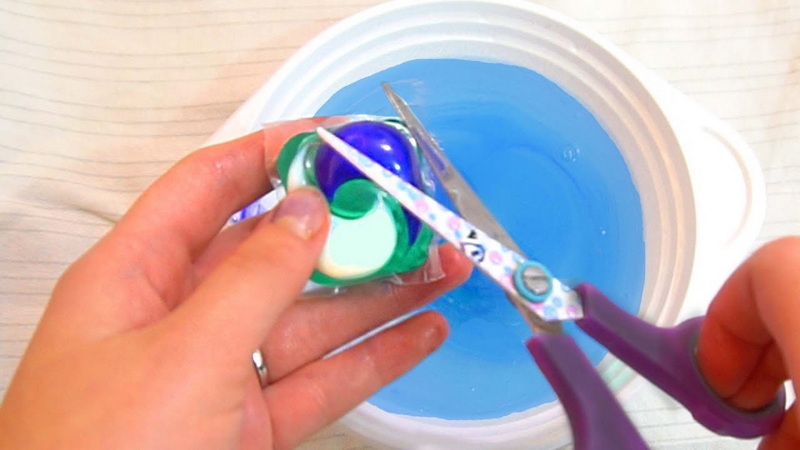Dongguan UFine Daily Chemical Co.,Ltd.
- All
- Product Name
- Product Keyword
- Product Model
- Product Summary
- Product Description
- Multi Field Search
Views: 222 Author: Tomorrow Publish Time: 11-02-2025 Origin: Site











Content Menu
● Texture and Consistency Tips
● FAQ
>> 1. What safety precautions should I take when using laundry pods in slime making?
>> 2. Can I make slime without glue?
>> 3. How long does slime stay usable?
>> 4. What if the slime smells odd or sizzles?
>> 5. How can I customize color and texture safely?
Making slime is a fun, hands-on activity that blends science and creativity. This guide explains a straightforward method to create slime using common household items, including laundry pods. It covers safety considerations, step-by-step instructions, and variations to tailor texture and color. The process emphasizes clean-up and proper disposal of materials to ensure a safe, enjoyable experience for hobbyists of all ages.

Slime has grown from a quirky trend into a versatile crafting material used for sensory play, stress relief, and decorative purposes. While many slime recipes rely on glue and borax, this guide explores an alternative approach using readily available items, including laundry pods, to achieve a stretchable, squeezable texture. Readers should exercise caution with household chemicals and supervise younger participants.
- Laundry pods (detergent pods)
- White school glue or clear school glue
- Water
- Borax solution or saline solution (to activate) or a glue-softening approach
- Food coloring (optional)
- Mixing bowls
- Measuring spoons
- Stirring sticks or spoons
- Protective gloves (optional for sensitive skin)
- Laundry pods contain concentrated detergents and surfactants. Never open pods or handle contents directly without gloves.
- Do not ingest slime or its ingredients. Wash hands after handling.
- Keep all materials away from eyes and out of reach of small children and pets.
- If skin irritation occurs, rinse with plenty of water and discontinue use.
1. Prepare your workspace and wear gloves if desired.
2. In a bowl, combine a small amount of glue with warm water in a 1:1 ratio to create a base mixture.
3. Add a few drops of food coloring to achieve your desired color; mix thoroughly.
4. Carefully rupture a laundry pod and extract a small amount of the interior liquid onto the glue mixture. Do not touch the pod directly with bare skin.
5. Add a small amount of borax solution or saline solution to the glue–pod mixture while stirring. The contact with the liquid should begin to form a slime-like consistency.
6. Knead the mixture with your hands until it reaches the desired stretchiness. If too sticky, add a touch more borax solution or saline; if too stiff, add a few drops of water and re-knead.
7. Continue mixing and kneading until smooth and cohesive. Adjust color or texture as desired.
8. Store slime in an airtight container between uses.

- For a stretchier slime, increase the glue ratio and add small amounts of water during kneading.
- To make fluffy slime, incorporate a small amount of shaving cream before adding the activator.
- If the slime tears, re-wet with a few drops of water and knead thoroughly.
- Scented slime: Add a drop or two of food-safe essential oil or fragrance before kneading.
- Glitter slime: Mix in cosmetic-grade glitter after coloring.
- Glow-in-the-dark slime: Use glow-in-the-dark paint or pigment in the coloring step.
- Slime too sticky: Add a little more activator gradually while kneading.
- Slime too stiff or rubbery: Rehydrate with water or a small amount of saline solution and knead longer.
- Uneven color: Mix thoroughly and add more color gradually.
- Do not pour excessive slime or soapy mixtures down the drain. Scrape slime into a trash bag and rinse bowls with warm water.
- Wipe surfaces with a damp cloth after play sessions to remove any residue.
Slime made with everyday materials, including laundry pods, offers an engaging way to explore texture, color, and basic chemistry. By following careful safety practices and using the steps outlined above, you can create a satisfying, squeezable slime suitable for creative play and learning experiences.

- Wear gloves to protect skin, avoid contact with eyes, and keep pods out of reach of children and pets. Do not ingest or crush pods directly.
- Yes, alternative slime recipes exist that use different binding agents, but the glue-based method described here is common and reliable for texture.
- Properly prepared slime can last several days to weeks when stored in an airtight container, depending on humidity and handling.
- Discontinue use immediately. Wash hands, and discard the mixture if you detect unusual odors or fizzing indicating chemical reactions.
- Use cosmetic-safe pigments or food coloring, and adjust glue, activator, and water proportions to achieve your preferred texture.